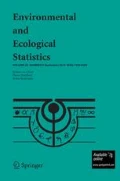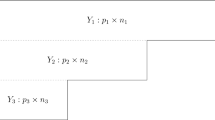Abstract
We study a continuous-time removal model for estimating the population size for a population in which a sub-population size ratio is known. The maximum likelihood estimate and the optimal martingale estimate of the population size are obtained; these are shown to be equivalent. A comparison between the proposed estimator and the maximum likelihood estimate which ignores the information on the known size ratio is made, using a simulation study. The asymptotic variances of these two estimators are also obtained, and a comparison between them is made. The sensitivity of mis-specification of the known size ratio is examined. We also apply the corresponding discrete-time model to the proposed continuous-time setting, and study the efficiency of the corresponding discrete-time type estimator relative to the proposed estimator.
Similar content being viewed by others
References
PK Andersen Ø Borgan RD Gill N Keiding (1993) Statistical models based on counting processes Springer-Verlag New York
AD Carothers (1973) ArticleTitleThe effects of unequal catchability on Jolly–Seber estimates Biometrics 29 29–100
A Chao (1987) ArticleTitleEstimating the population size for capture-recapture data with unequal catchability Biometrics 43 783–791 Occurrence Handle1:STN:280:BieC3cjpvFU%3D Occurrence Handle3427163
A Chao (2001) ArticleTitleAn overview of closed capture-recapture models J Agric Biol Environ Stat 6 158–175
M Falck (1996) Small mammal population dynamics in riparian zones of regulated versus unregulated rivers in northwestern Colorado Colorado State University Fort Collins
VP Godambe (1985) ArticleTitleThe foundations of finite-sample estimation in stochastic processes Biometrika 72 419–428
DY Lin PSF Yip (1999) ArticleTitleParametric regression models for continuous time removal and recapture studies J Roy Stat Soc Ser B 61 401–411
L Liu PSF Yip RK Watson (2003) ArticleTitleRemoval process estimation of population size for a population with a known sex ratio Environ Ecol Stat 10 281–292 Occurrence Handle10.1023/A:1023655030828
KH Pollock (1991) ArticleTitleModeling capture, recapture and removal statistics for estimation of demographic parameters for fish and wildlife populations: past, present and future J Am Stat Assoc 86 225–238
KR Wilson DR Anderson (1995) ArticleTitleContinuous-time capture-recapture population estimation when capture probability varies over time Environ Ecol Stat 2 55–69 Occurrence Handle10.1007/BF00452931
Author information
Authors and Affiliations
Corresponding author
Rights and permissions
About this article
Cite this article
Xi, L., Yip, P.S.F. & Watson, R. Estimating Population Size in a Continuous-time Removal Experiment with a Known Sub-population Size Ratio. Environ Ecol Stat 13, 109–124 (2006). https://doi.org/10.1007/s10651-005-5694-y
Issue Date:
DOI: https://doi.org/10.1007/s10651-005-5694-y




